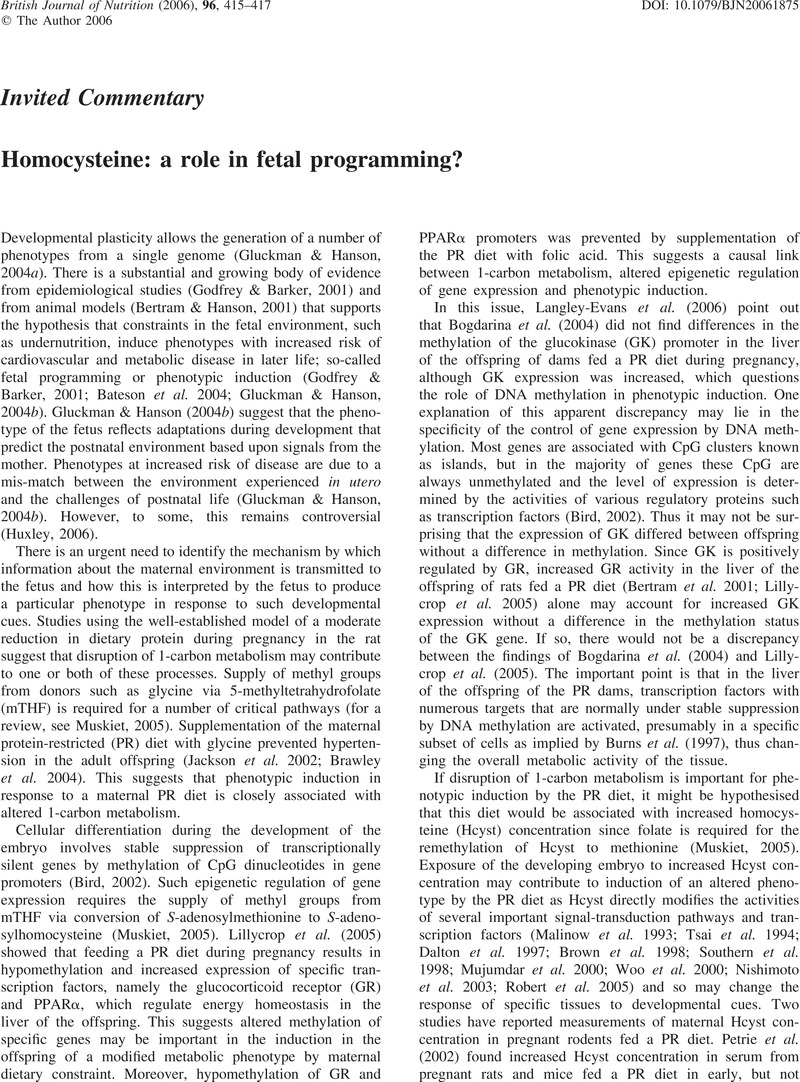No CrossRef data available.
Article contents
Homocysteine: a role in fetal programming?
Published online by Cambridge University Press: 19 February 2008
Abstract
An abstract is not available for this content so a preview has been provided. As you have access to this content, a full PDF is available via the ‘Save PDF’ action button.

- Type
- Invited Commentary
- Information
- Copyright
- Copyright © The Nutrition Society 2006
References
Bateson, P, Barker, D, Clutton-Brock, T, et al. (2004) Developmental plasticity and human health. Nature 430, 419–421.Google Scholar
Bertram, C, Trowern, AR, Copin, N, Jackson, AA & Whorwood, CB (2001) The maternal diet during pregnancy programs altered expression of the glucocorticoid receptor and type 2 11beta-hydroxysteroid dehydrogenase: potential molecular mechanisms underlying the programming of hypertension in utero. Endocrinology 142, 2841–2853.Google Scholar
Bertram, CE & Hanson, MA (2001) Animal models and programming of the metabolic syndrome. Br Med Bull 60, 103–121.Google Scholar
Bogdarina, I, Murphy, HC, Burns, SP & Clark, AJ (2004) Investigation of the role of epigenetic modification of the rat glucokinase gene in fetal programming. Life Sci 74, 1407–1415.Google Scholar
Brawley, L, Torrens, C, Anthony, FW, Itoh, S, Wheeler, T, Jackson, AA, Clough, GF, Poston, L & Hanson, MA (2004) Glycine rectifies vascular dysfunction induced by dietary protein imbalance during pregnancy. J Physiol 554, 497–504.Google Scholar
Brown, JC, Rosenquist, TH & Monaghan, DT (1998) ERK2 activation by homocysteine in vascular smooth muscle cells. Biochem Biophys Res Comm 251, 669–676.Google Scholar
Burns, SP, Desai, M, Cohen, RD, Hales, CN, Iles, RA, Germain, JP, Going, TC & Bailey, RA (1997) Gluconeogenesis, glucose handling, and structural changes in livers of the adult offspring of rats partially deprived of protein during pregnancy and lactation. J Clin Invest 100, 1768–1774.Google Scholar
Dalton, ML, Gadson, PF, Wrenn, RW & Rosenquist, TH (1997) Homocysteine signal cascade: production of phospholipids, activation of protein kinase C, and the induction of c-fos and c-myb in smooth muscle cells. FASEB J 11, 703–711.CrossRefGoogle ScholarPubMed
Godfrey, KM & Barker, DJ (2001) Fetal programming and adult health. Public Health Nutr 4, 611–624.Google Scholar
Gluckman, PD & Hanson, MA (2004a) The developmental origins of the metabolic syndrome. Trends Endocrinol Metab 15, 183–187.Google Scholar
Gluckman, PD & Hanson, MA (2004b) Living with the past: evolution, development, and patterns of disease. Science 305, 1733–1736.Google Scholar
Jackson, AA, Dunn, RL, Marchand, MC & Langley-Evans, SC (2002) Increased systolic blood pressure in rats induced by a maternal low-protein diet is reversed by dietary supplementation with glycine. Clin Sci (London) 103, 633–639.Google Scholar
Kwong, WY, Wild, AE, Roberts, P, Willis, AC & Fleming, TP (2000) Maternal undernutrition during the preimplantation period of rat development causes blastocyst abnormalities and programming of postnatal hypertension. Development 127, 4195–4202.Google Scholar
Langley-Evans, SC, Lilley, C & McMullen, S (2006) Maternal protein restriction and fetal growth: lack of evidence of a role for homocysteine in fetal programming. Br J Nutr 96, 578–586.Google Scholar
Lillycrop, KA, Phillips, ES, Jackson, AA, Hanson, MA & Burdge, GC (2005) Dietary protein restriction of pregnant rats induces and folic acid supplementation prevents epigenetic modification of hepatic gene expression in the offspring. J Nutr 135, 1382–1386.Google Scholar
Malinow, MR, Nieto, FJ, Szklo, M, Chambless, LE & Bond, G (1993) Carotid artery intimal-medial wall thickening and plasma homocyst(e)ine in asymptomatic adults. The Atherosclerosis Risk in Communities Study. Circulation 87, 1107–1113.Google Scholar
Mujumdar, VS, Hayden, MR & Tyagi, SC (2000) Homocyst(e)ine induces calcium second messenger in vascular smooth muscle cells. J Cell Physiol 183, 28–36.3.0.CO;2-O>CrossRefGoogle ScholarPubMed
Muskiet, FA (2005) The importance of (early) folate status to primary and secondary coronary artery disease prevention. Reprod Toxicol 20, 403–410.Google Scholar
Nishimoto, S, Tawara, J, Toyoda, H, Kitamura, K & Komurasaki, T (2005) A novel homocysteine-responsive gene, smap8, modulates mitogenesis in rat vascular smooth muscle cells. Eur J Biochem 270, 2521–2531.CrossRefGoogle Scholar
Petrie, L, Duthie, SJ, Rees, WD & McConnell, JM (2002) Serum concentrations of homocysteine are elevated during early pregnancy in rodent models of fetal programming. Br J Nutr 88, 471–477.Google Scholar
Robert, K, Pages, C, Ledru, A, Delabar, J, Caboche, J & Janel, N (2005) Regulation of extracellular signal-regulated kinase by homocysteine in hippocampus. Neuroscience 133, 925–935.Google Scholar
Southern, FN, Cruz, N, Fink, LM, Cooney, CA, Barone, GW, Eidt, JF & Moursi, MM (1998) Hyperhomocysteinemia increases intimal hyperplasia in a rat carotid endarterectomy model. J Vasc Surg 28, 909–918.Google Scholar
Tsai, JC, Perrella, MA, Yoshizumi, M, Hsieh, CM, Haber, E, Schlegel, R & Lee, ME (1994) Promotion of vascular smooth muscle cell growth by homocysteine: a link to atherosclerosis. Proc Natl Acad Sci U S A 91, 6369–6373.CrossRefGoogle ScholarPubMed
Woo, DK, Dudrick, SJ & Sumpio, BE (2000) Homocysteine stimulates MAP kinase in bovine aortic smooth muscle cells. Surgery 128, 59–66.Google Scholar




